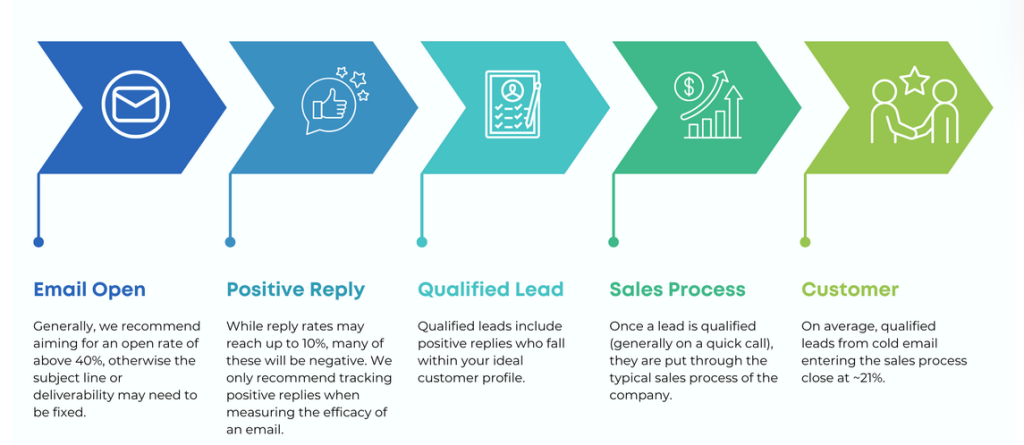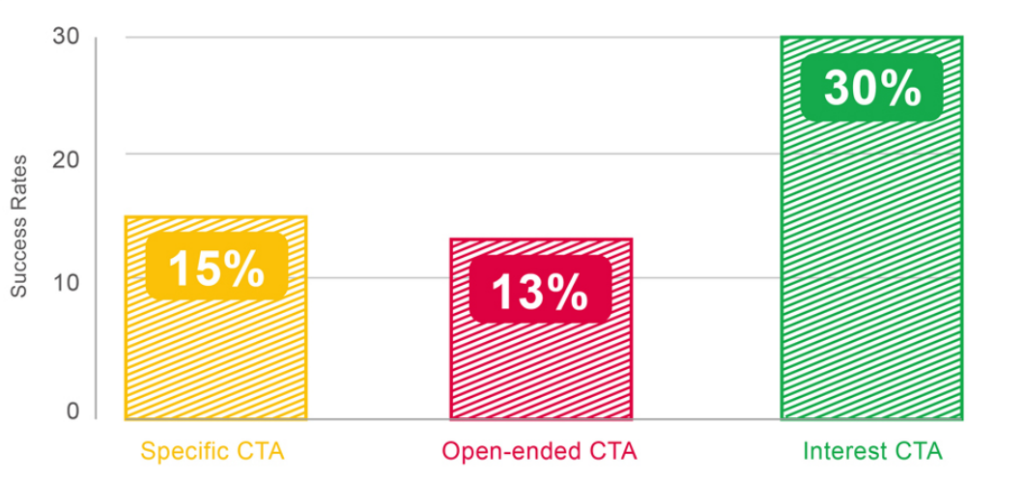- Home
- Statistics and Analytics
- What Is a Good Cold Email Conv ...

Cold emailing has a certain reputation. While it is true that reaching out to a prospect’s inbox is less intrusive than a cold call and often preferred by buyers, the vast majority of unsolicited emails still get ignored (around 91.5% of cold outreach messages go unanswered).
With such mixed outcomes, it’s no wonder marketers keep asking, What is a good conversion rate for cold emails? It turns out that “good” is a relative term and usually a rather modest number. In other words, the typical conversion rate remains around one percent or less.
In this article, we’ll break down how to understand cold email conversion rates, what factors influence these rates, how many cold emails you need to get a client, and what data says about good vs. bad performance. Finally, we’ll cover strategies to boost your cold email conversions so you can squeeze more value out of every send.
Understanding Cold Email Conversion Rate
In the context of cold emailing, a “conversion” refers to the recipient taking the desired action— becoming a lead or customer. Put simply, a cold email conversion rate tells you how many paying customers you get per email sent.
It’s important to distinguish conversion rates from other email metrics like open rate or reply rate. An open rate is just the percentage of recipients who open your email, and reply rate is the percentage of those who send any response. Those are useful metrics—in the end you need your emails opened and replied to to get conversions. But a campaign might have a high open or reply rate and still have a poor conversion rate if none of those replies turn into opportunities. For example, while the typical cold email reply rate is around 8.5%, most of those responses are negative, and it often takes about 100 cold emails just to land one meeting.
This leads to some common pitfalls in interpreting cold email metrics. One pitfall is celebrating vanity metrics (bragging about a 60% open rate) without tracking whether those opens convert into anything meaningful. Another trap is confusing any reply with success. If your campaign’s 5% reply rate is mostly “Not interested” or “Remove me from your list,” the real conversion rate might still be zero. So, measuring conversion in a cold email should focus on meaningful outcomes like a booked call or a deal and not just activity.
Cold email conversion process

Factors That Affect Cold Email Conversion
🔹 One big factor is the target industry and audience. Some industries are simply tougher nuts to crack via cold email. It can be explained by higher email competition or the audience doing business mainly via other sources. Other niches, on the contrary, might be more receptive. In fact, average conversion rates can vary widely by industry—for example, cold emails in SaaS averaged as low as 0.03%, whereas sectors like real estate or energy saw closer to 0.3%.
🔹 Another crucial factor is recognition and trust. If your company or personal brand is recognizable (or at least doesn’t seem sketchy), prospects are more likely to engage. In other words, an email coming from a known, credible source has a much better chance to convert.
🔹 Then there are the tactical and technical factors. One is email volume and personalization. There’s an inverse relationship here: the more people you reach, the less personalized your message tends to be, and that lowers conversion rates. Additionally, email deliverability plays a foundational role. If your message never lands in the inbox, it can’t convert. This is why maintaining good sending practices, like having attractive subject lines, is so important. In fact, 70% of cold emails that get marked as spam are flagged due to their subject line.
🔹 Finally, timing and persistence are factors that can make or break conversions. Many conversions happen only after the second or third touch. Likewise, choosing the right timing (day and hour) can have an impact too. For example, midweek tends to outperform other days for cold email engagement, and that is worth considering.
What Is a Good Email Conversion Rate?
The honest answer: anything in the low single digits can be considered good (even outstanding campaigns only reach high single digits). That might sound underwhelming, but in cold outreach, a little goes a long way. According to data, the average cold email conversion rate is around 0.215% (roughly one customer per 464 emails sent). With such a low baseline, even doubling that is an achievement.
For additional perspective, let’s compare cold email conversions to some other email types. Cold emails inherently target an audience that isn’t expecting to hear from you, so the bar is much lower than for warm email campaigns. For example, opt-in newsletters or marketing emails often see click-through rates around 2–5% on average. Transactional emails (like order confirmations or password resets) perform even better, as they are often considered “must-open” messages. Research suggests that transactional emails get 8x more opens and clicks than regular marketing emails. People pay attention to them because they’re directly relevant to an action the user takes.
The takeaway here is that cold email conversion rates will naturally be lower than conversions from engaged audiences. If your cold email campaign converts 2% of complete strangers into customers, that might, in fact, outperform a typical warm newsletter that converts 5% of already engaged subscribers.

What Is a Bad Email Conversion Rate?
Now that we’ve figured out what a good email conversion rate is, what counts as a bad conversion rate for cold emails? Considering how low the averages are, “bad” usually means essentially no meaningful conversions at all. If you send out a campaign and get zero replies or zero customers, that’s definitely a bad outcome. Generally, if your conversion rate is well below the 0.2%–0.5% average range, it’s a sign of trouble.
Such a low conversion rate typically goes hand-in-hand with weak early-stage metrics. If your emails are converting poorly, you’ll often see warning signs like low open and reply rates. This, in turn, suggests something is fundamentally off with your approach—maybe your email content is not compelling, your targeting is too broad, or your deliverability is suffering.
In practical terms, if your cold email conversion rate is below ~0.1% (one in a thousand), it’s a red flag. It indicates that something isn’t working. Even within cold email, where low numbers are normal, you should expect at least a fraction of positive outcomes if you do things right. “Bad” means you’re not even getting that. The good news is, if you do find yourself in that territory, there are concrete ways to improve and climb out of it.
Strategies to Increase Cold Email Conversions
✅ Improve your targeting and personalization
Start by emailing the right people and avoid random lists. Add small personal touches, like something specific about their company. It doesn’t have to be ultra-detailed, but show that you’ve done your homework.
✅ Come up with an irresistible subject line and opening
Make your subject line sound natural and a little curious. Avoid all caps or over-promising. And don’t forget your opening line—it should make them want to keep reading.
✅ Include a friendly CTA
Avoid asking for too much upfront. Instead, try simple, casual CTAs like “Open to hearing more?” or “Can I send over a quick case study?” Keep your ask small and approachable, and people will be more willing to say yes.
Cold email CTA rating

✅ Follow up (persistently but smartly)
People miss emails. Following up once or twice shows you’re serious (just don’t be too serious too often). Space your messages out and keep them friendly. A quick reminder with a new angle or a one-sentence nudge is often all you need.
✅ Ensure deliverability and timing are on point
Even the best email won’t convert if it ends up in spam. Make sure your domain’s warmed up, your list is clean, and you’re not sending during odd hours. Mid-week mornings usually work best—but test what fits your audience.
To Sum Up
Cold email conversion rates may never be the jaw-dropping numbers. But for business professionals, even those modest numbers can translate into real deals and revenue when scaled. If you’re converting more than 1% of cold contacts into clients, you are doing a great job by industry standards.
The data reminds us that cold emailing is a tough arena, but not an impossible one. Knowing the benchmarks helps set realistic goals: you won’t close every prospect, and that’s okay. The key is to continuously refine your process to bump that conversion a little higher. By understanding what influences cold email success (from industry norms to the wording of your subject line) and applying best practices, you can tilt the odds in your favor. Happy emailing!



